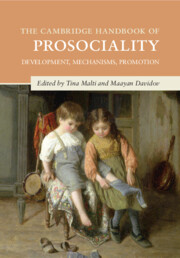Refine search
Actions for selected content:
101 results
Maternal perinatal depression and infant self-regulation: A meta-analytic review
-
- Journal:
- Development and Psychopathology , First View
- Published online by Cambridge University Press:
- 21 November 2025, pp. 1-20
-
- Article
-
- You have access
- Open access
- HTML
- Export citation

Theory of Mind in Childhood
-
- Published online:
- 20 October 2025
- Print publication:
- 13 November 2025
-
- Element
- Export citation
10 - Social Transformations during Infancy
- from Part III - Lifespan Development in Diverse Sociocultural Contexts
-
-
- Book:
- The Cambridge Handbook of Psychological Anthropology
- Published online:
- 22 October 2025
- Print publication:
- 25 September 2025, pp 253-274
-
- Chapter
- Export citation
Chapter 5 - Maturation
- from Part I - Basics
-
- Book:
- How to Read an EEG
- Published online:
- 27 September 2025
- Print publication:
- 24 July 2025, pp 42-56
-
- Chapter
- Export citation
Chapter 4 - Attachment Theory
- from Part I - The Beginnings of Meaning
-
- Book:
- The Development and Organization of Meaning
- Published online:
- 11 June 2025
- Print publication:
- 26 June 2025, pp 35-49
-
- Chapter
- Export citation
Chapter 3 - The Cradle of Meaning
- from Part I - The Beginnings of Meaning
-
- Book:
- The Development and Organization of Meaning
- Published online:
- 11 June 2025
- Print publication:
- 26 June 2025, pp 25-34
-
- Chapter
- Export citation
Longitudinal associations between the infant gut microbiome and negative affect in toddlerhood
-
- Journal:
- Development and Psychopathology , First View
- Published online by Cambridge University Press:
- 05 June 2025, pp. 1-13
-
- Article
-
- You have access
- Open access
- HTML
- Export citation
Let’s go WILD: Increasing Inclusivity in Theories of Developmental Psychology
-
- Journal:
- Behavioral and Brain Sciences / Accepted manuscript
- Published online by Cambridge University Press:
- 23 May 2025, pp. 1-60
-
- Article
- Export citation
Cross-talker lexical tone discrimination in infancy
-
- Journal:
- Journal of Child Language , First View
- Published online by Cambridge University Press:
- 22 April 2025, pp. 1-24
-
- Article
-
- You have access
- Open access
- HTML
- Export citation
Predicting autism from young Infants’ empathic responding: A prospective study
-
- Journal:
- Development and Psychopathology / Volume 37 / Issue 3 / August 2025
- Published online by Cambridge University Press:
- 01 October 2024, pp. 1416-1430
-
- Article
-
- You have access
- Open access
- HTML
- Export citation
Maternal depressive symptoms and infants’ emotional reactivity: The moderating role of mothers’ prenatal cry processing
-
- Journal:
- Development and Psychopathology / Volume 37 / Issue 3 / August 2025
- Published online by Cambridge University Press:
- 19 September 2024, pp. 1431-1443
-
- Article
-
- You have access
- Open access
- HTML
- Export citation
Chapter 3 - Redefining Subjectivity and Intersubjectivity for a New Method
- from Part II - Elements of Collaborative Competence
-
- Book:
- Developing Together
- Published online:
- 07 May 2024
- Print publication:
- 09 May 2024, pp 47-63
-
- Chapter
- Export citation
21 - Gesture in Learning and Education
- from Part IV - Gestures in Relation to Cognition
-
-
- Book:
- The Cambridge Handbook of Gesture Studies
- Published online:
- 01 May 2024
- Print publication:
- 18 April 2024, pp 556-576
-
- Chapter
- Export citation
12 - Morality, Values, and Prosociality across Development
- from Part II - Antecedents and Mechanisms of Prosociality
-
-
- Book:
- The Cambridge Handbook of Prosociality
- Published online:
- 25 May 2023
- Print publication:
- 08 June 2023, pp 233-255
-
- Chapter
- Export citation

The Cambridge Handbook of Prosociality
- Development, Mechanisms, Promotion
-
- Published online:
- 25 May 2023
- Print publication:
- 08 June 2023
Microbiota and probiotics: chances and challenges – a symposium report
-
- Journal:
- Gut Microbiome / Volume 4 / 2023
- Published online by Cambridge University Press:
- 27 March 2023, e6
-
- Article
-
- You have access
- Open access
- HTML
- Export citation
Milk–cereal mix supplementation during infancy and impact on neurodevelopmental outcomes at 12 and 24 months of age: a randomised controlled trial in India
-
- Journal:
- British Journal of Nutrition / Volume 130 / Issue 5 / 14 September 2023
- Published online by Cambridge University Press:
- 21 December 2022, pp. 868-877
- Print publication:
- 14 September 2023
-
- Article
-
- You have access
- Open access
- HTML
- Export citation
Social motivation in infancy is associated with familial recurrence of ASD
-
- Journal:
- Development and Psychopathology / Volume 36 / Issue 1 / February 2024
- Published online by Cambridge University Press:
- 03 October 2022, pp. 101-111
-
- Article
- Export citation
19 - A Review of Interventions to Promote Language Development in Early Childhood
- from Part Three - Impact, Intervention and Equity
-
-
- Book:
- Language Development
- Published online:
- 11 August 2022
- Print publication:
- 25 August 2022, pp 443-469
-
- Chapter
- Export citation
Increases in maternal depressive symptoms during pregnancy and infant cortisol reactivity: Mediation by placental corticotropin-releasing hormone
-
- Journal:
- Development and Psychopathology / Volume 35 / Issue 4 / October 2023
- Published online by Cambridge University Press:
- 19 August 2022, pp. 1997-2010
-
- Article
-
- You have access
- Open access
- HTML
- Export citation
